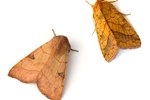
Despite its name the firefly isn’t a fly at all, it's a beetle. Its glow comes from a chemical reaction that produces light without heat. Fireflies use their lights to find mates. In some cases the light also deters predators; the common eastern firefly contains a toxic steroid. The average life span of a firefly is about two years from the time it emerges from the egg until it dies, though this varies somewhat by species.
Flashing and Mating
Typically the male fireflies fly around flashing and looking for females, who wait on the ground or in bushes. Each species has its own flashing pattern, and when a female sees one she likes she answers with flashes of her own. She chooses a male not only by the pattern, but also by how brightly he flashes and how long the flashes are. Because the males with the best flashing patterns are usually the strongest and the biggest, her choice helps to insure the best father for her offspring.
Glowing Eggs
The female firefly lays about 500 eggs in damp soil in sheltered spots, singly or in small groups. It takes about a month until the tiny larval fireflies hatch and begin feeding as they prepare for the time when they will become pupae. Some firefly eggs glow, and they’ll flash a bit if they're tapped or subjected to other vibrations.
Long-Term Larvae
The larval period is the longest stage that fireflies go through, and it can last anywhere from one to three years. Larval fireflies look like small worms and crawl about on the ground. They inject a digestive enzyme into their prey -- earthworms, snails, slugs and sometimes other insects -- and then they suck out the liquid after the enzyme has done its work. Some species mimic the flashing patterns of other fireflies to lure in the males, and then devour them when they get too close.
Pupae and Adulthood
When a firefly larvae is big enough, it digs into the ground and pupates, forming a hard exterior shell that will protect it during this part of its life. The pupa will undergo a metamorphosis from a crawling larva to an adult firefly, emerging from in early summer. Although some adult fireflies eat, many don’t because they live only a few weeks, just long enough to find mates and reproduce.
References
Photo Credits
-
Brand X Pictures/Brand X Pictures/Getty Images



